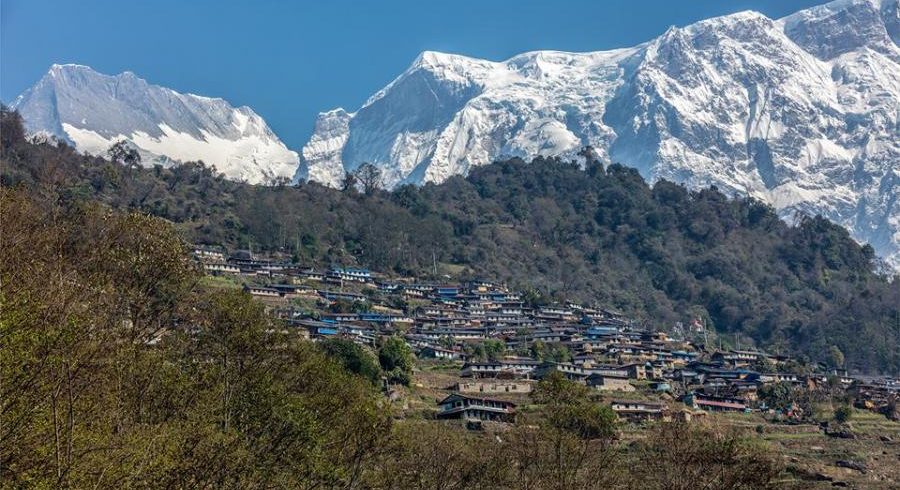When’s the best time to visit Nepal?
The main seasons for trekking are the spring (Mar to May) and autumn (Sep to Nov) when you’ll have clear skies and superb mountain views. The winter (Dec to Feb) is also a great time to visit— these months offer a unique experience and fewer crowds but lower altitude treks are better at this time of year as its cold at night.
What is it like during the monsoon season?
(Jun to Aug), Most of Nepal experiences heavy rain for a few hours each day. It’s humid, wet, and the trails in the lower regions (Ghorepani, Ghandruk, Langtang, etc) can be quite muddy. If you don’t mind the rain you’ll have the trails to yourself, the skies often clear up in the morning, and certain treks offer stone-paved trails that drain the rain and make for easy trekking. Also, certain regions, like Mustang and the upper reaches of Everest, lie in the rainshadow of the Himalaya and receive little rain but views however are still likely to be restricted.
showers.
Is Wi Fi available on treks:
The main trekking regions of Everest / Annapurna / Langtang have Wi Fi facilities on the major trekking routes. There will be times when trekking in remote areas when it is not available.
What is Altitude Sickness?
Above 2500 meters you may feel a slight headache but rarely anything more that a painkiller won’t relieve. If we are talking about the possibility of contracting a more severe form of altitude sickness it is likely to occur over 4.000 meters and once again rare and easily resolved by descending to a lower altitude. Altitude sickness describes several symptoms that happen to your body when you’re exposed to a higher elevation within a short period of time. When people are traveling or either climbing to a higher elevation quickly. The higher you climb, the lower the air pressure and oxygen levels get. Our bodies can handle the shift, but they need time to gradually adjust. Himalaya Heart carefully designs treks to minimise any risk.Having said that genrally people will experience the following to a lesser or higher degree.
Lack of appetite/ nausea /Fatigue/ Shortness of breath
Money and payment in Nepal.
Payment in hotels, trekking/travel agencies, and airlines are made in foreign exchange. Most of the International Cards including Visa Card, Master Card, JCB, Maestro, Americal Express etc. are widely accepted by hotels, restaurants and leading travel/trekking agents. The receipts may be needed to change left-over Nepalese Rupees into hard currency before leaving the country. However, only 10 percent of the total amount may be converted by the bank. ATM and Debit cards are widely in use in major cities of Kathmandu, Pokhara, Chitwan, Lumbini and others.
Nepalese Rupees are found in denominations of 1000, 500, 100, 50, 20, 10, 5, 2 and 1. One rupee equals 100 paisa. The rate regularly fluctuates and is fixed and published by Nepal Rastra Bank every other day.
What’s the difference between private and group tours?
Private tours are tailor-made itineraries built by us around your travel dates and personal interests, whereas group trips are pre-packaged and depart on specific dates. Group trips are also open for others to join, whereas private trips are just for you. You will find a list of fixed departure dates on our website.
How do I get my visa for Nepal?
For most nationalities visa can be obtained on arrival in Kathmandu. It takes around 45 minutes and is the most convenient way to get your visa you will need passport size photos.. You can also apply for a visa in advance from a local Nepali consulate in your country if you’d like to have everything arranged in advance. Cost15 Days – 25 USD / 30 Days – 40 USD / 90 Days – 100 USD
How much luggage can I take on domestic flights?
For mountain flights, you’re allowed 5 kg. carry-on to the plane and 10 kg. for checked-in luggage. For non-mountain sector flights, the check-in allowance increases to 20-25 kg.
Are hotels included in the tour price?
Himalaya Heart organise complete tours, meaning everything is taken care of from the moment you arrive in Nepal to the moment you leave, including all of your accommodation in a three star Hotel. If you require better accommodation please let us know and we can arrange this and adjust the tour cost accordingly. Each of our tour pages shows clearly what is and what is not included in the tour price.
Are there any extra expenses not included in my tour price?
Personal expenses (tips, soft drinks, bar bills, laundry, telephone calls, donations, and extra snacks, etc) are not included in your tour price. When checking a particular trek page on our website we have clearly stated what is and what is not included. If you’re going trekking, the only things you’ll need to pay for out of pocket are wifi and battery charging (when available), extra meals outside of what’s included, alcohol, and soft drinks and hot showers on trek.

 +977 9851093973 (Thakur)
+977 9851093973 (Thakur)
